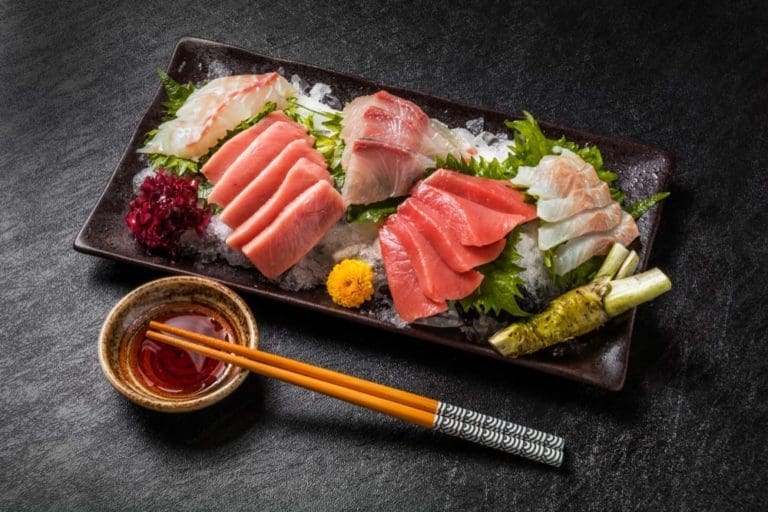
October 19, 2018
Nigiri vs Sashimi: What’s the Difference?
When it comes to food, there is no cuisine that is quite as divisive as sushi.
Given that it’s raw fish, this is perhaps not surprising – even the most adventurous Americans may refuse to try sushi.
“I don’t like raw fish, so why would I like sushi, or want to try it?” is a common complaint that you may hear. That’s why about 1 in 3 Americans refuse to try sushi.
And there is a bit of valid criticism there – most of us probably associate raw fish with supermarket fish counters, or frozen and uncooked fish filets, which are typically not the most high-quality fish on the market.
But if you – or anyone you know – refuses to try sushi because you don’t like the idea of eating raw fish, you’re missing out. Great sushi is made with the most fresh, high-quality fish like tuna and salmon. Not only is it totally safe it eat, it’s an absolutely unique culinary experience.
In fact, it’s possible that eating a piece of firm salmon nigiri, paired with a delicious and traditional sake, is one of the best flavor experiences you can have – without spending money at a 4-star Michelin-rated restaurant!
Beyond the contentiousness of raw fish, you may also be a bit confused about what the difference is between sashimi and nigiri – the two most common types of sushi – which may stop you from ordering sushi when you’re out to dinner.
So what’s the difference – and which ones should you try? In this guide, we’ll explain all of the differences between nigiri and sashimi, so that you can open your mind – and your palate – to the unique, delicious flavor of sushi.
Nigiri
Directly, Nigiri translates to “two fingers”. As the name implies, this is a small, delicious treat that features a thinly-sliced drapery of raw fish, laid over a cluster of sweet and salty vinegared rice. The roll is chilled, and the smooth taste of the fish combines with the sticky and tangy flavor of the rice to create an absolutely superb mouthfeel.
If you ask a traditionalist, they may say that nigiri is a bit more traditional than sashimi, due to the purity and simplicity of the ingredients. We would tend to agree – if you want a truly authentic sushi experience, it’s hard to beat a few top-quality sashimi.
Like other forms of sushi, it’s acceptable to eat nigiri with either your hands or chopsticks. And if you use a fork, nobody’s going to turn their nose up at you – you can eat it however you want!
You may notice that we have not mentioned any kind of tight sushi “roll” – and that’s because, though it is sushi, nigiri does not come in any kind of traditional, rolled form (typically called “Makizushi”).
In fact, neither nigiri or sashimi comes in a roll-based, Makizushi form, which is the most popular type of sushi in America, by far – but the least authentic.
New to nigiri, and not sure what to get? The best nigiri sushi is typically made with bluefin tuna, salmon, or halibut. These types of fish are very firm, and have a relatively high fat content that makes them melt in your mouth, and which perfectly matches the sweetness and saltiness of the rice.
Sashimi
While some folks may use the terms sashimi and nigiri interchangeably, they’re actually quite different. Why?
Because sashimi is not, technically, a form of sushi at all. Yes, it involves raw fish – but it does not include rice of any kind. Rice is an essential component for sushi.
Sashimi, on the other hand, translates to “pierced body” or “pierced meat”. As the name implies, it’s composed only of extremely thin, delicately cut strips of raw meat. There is no rice used to enhance the flavor of the fish – it stands on its own, and is eaten with just a dab of soy sauce, in the traditional style.
And, unlike nigiri, sashimi is not confined only to fish. Although most restaurants serve sashimi composed of salmon, shrimp, and squid, it may contain other meats, like chicken or horse – which are hard to find in most American sushi restaurants.
If you’re looking for an authentic sashimi experience, but the idea of eating raw fish or meat without any other kind of garnish makes you feel a bit skittish or uncomfortable, “tataki” may be a good middle ground.
Tataki is seared lightly and marinated to bring out the natural flavors of the meat. Much of the meat is still raw, but the flavor is more similar to cooked fish. This makes it a bit more approachable, and easier to stomach if you’ve never tried raw fish before.
If you’re considering sashimi for the first time, the best place to start is with shrimp, salmon, and octopus.
Nigiri Vs. Sashimi: Final Thoughts
Nigiri and sashimi are both staples of traditional Japanese cuisine. However, it’s important to understand the distinction between the two. Nigiri uses rice, and is technically a type of sushi, while nigiri eschews rice, and can be made of fish or a different type of meat. It’s also not technically sushi – though it’s still served at most sushi joints.
So, who comes out the victor in the war between nigiri and sashimi? Whoever gets to eat, of course! Both are delicious, and great representations of traditional Japanese cuisine.
If you’ve never had authentic Japanese sushi before, though, we recommend nigiri. It’s more approachable, and more similar to the traditional sushi rolls that you may have tried in the past.
But whatever your preference, please get in touch and book your reservation online with Roka Akor now. You’ll get to try everything we have to offer – and you and your fellow diners will have an experience that you’re sure to cherish for years to come.
